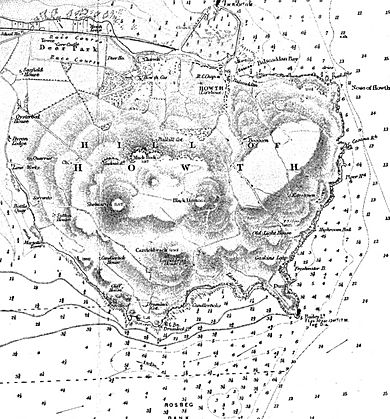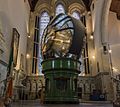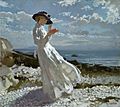Howth Head facts for kids
|
Ceann Bhinn Éadair
|
|
|---|---|

Aerial view of Howth Head looking south.
|
|
| Geography | |
| Location | Ireland |
| Adjacent bodies of water | |
| Area | 11 km2 (4.2 sq mi) |
| Highest elevation | 171 m (561 ft) |
| Highest point | Ben of Howth |
| Administration | |
| County | Dublin |
| Demographics | |
| Population | 8,294 (2016) |
| Pop. density | 754 /km2 (1,953 /sq mi) |
Howth Head (pronounced HOHTH) is a beautiful peninsula located northeast of Dublin city in Ireland. Its name in Irish is Ceann Bhinn Éadair. This area is managed by Fingal County Council. You can enter the headland at Sutton, while the charming village of Howth and its harbour are found on the north-eastern side. Most of Howth Head is covered by the Hill of Howth. There are also lovely beaches on the northern shores. The Baily Lighthouse stands proudly on the southeastern part of Howth Head.
Contents
A Look Back: Howth Head's History
Howth Head has a long and interesting past! One of the earliest mentions of this peninsula might be on an old map by Claudius Ptolemy. He called it Edri Deserta, which means "Edar's isolated place." On his map, it looked like an island, but we're not sure if it was truly separated from the mainland back then, or if his map wasn't perfectly accurate.
People have lived on Howth Head for a very long time, since at least 3000 B.C.E.! Scientists have found old shell piles (called middens) and a special stone tomb (a dolmen) from around 2200 B.C.E. Howth Head also appears in many old Irish legends and stories. A fishing village grew here, and the area developed a lot under the St. Lawrence family. They owned most of Howth Head from the late 1100s until recently. In the 1800s, an electric tramline was built, making it much easier for people to visit the whole hill.
Exploring Howth Head: Location and Landscape
Howth Head was once an island, but now it's connected to the mainland by a narrow strip of land called a tombolo. It forms the northern edge of the big curved Dublin Bay.
Most of this headland is quite hilly. Some of the highest points include Black Linn, which is 171 meters tall, near the Ben of Howth. Other hills are Shielmartin Hill (163 meters) and Dun Hill. You'll also find rocky areas like Muck Rock and Kilrock.
Howth has a very diverse coastline with many different features. There are steep sea cliffs, especially along the north coast. Some important spots along the coast include Cush Point, Claremont Strand, and Balscadden Bay. You can also see the Great and Little Baily, Lion's Head, and Doldrum Bay.
Because of its rocky nature and thin soil, Howth has many streams. These streams flow quickly over the hard rock underneath. Some of them are called the Bloody Stream, the Boggeen Stream, and the Whitewater Brook.
Wildlife and Plants of Howth Head
Howth Head is a fantastic place for nature lovers! The cliffs are home to a large group of seabirds. You can spot razorbills, common guillemots, fulmars, kittiwakes, and cormorants nesting here.
The bushy areas above the cliffs are great for other birds. Look out for skylarks, meadow pipits, whitethroats, linnets, stonechats, and whinchats. If you're lucky, you might even see birds of prey like kestrels, peregrine falcons, and common buzzards flying overhead.
One common plant you'll see growing in many places on the headland is gorse. It's a thorny bush with bright yellow flowers. However, during dry summers, gorse can catch fire easily, so it's important to be careful.
Getting Around Howth Head
It's easy to get to and around Howth Head! There are two railway stations nearby. Sutton station is on the northern edge of the tombolo, and Howth station is right in the village of Howth. Both stations are served by Dublin Area Rapid Transit (DART) trains, which run regularly to and from Dublin city centre.
In the past, there was a special tramway called the Hill of Howth Tramway. It ran between the stations around the head from 1901 to 1959. Today, Dublin Bus routes also serve the headland, making it easy to reach different parts. There's also a full road network, but some areas are best explored on foot using the many walking paths.
Fun Things to Do at Howth Head
Howth Head is a very popular spot for people looking for a day trip from Dublin. You can get there by car, bus, or by taking the DART train.
If you love hiking, Howth offers many different routes. You can try the famous Cliff Walk, or the Cliff Path Closed Loop. You could also hike up to the ancient stone pile (a cairn) on one of Howth's many hilltops.
On clear days, the views from Howth Head are amazing! You can see the Wicklow Mountains in the distance and Dublin city spread out below you. Sometimes, you can even see Slieve Donard, a tall mountain in Northern Ireland, which is about 90 kilometers (56 miles) away. And on very clear days, you might even spot Snowdon (1,085 meters) in Snowdonia National Park in Wales, which is about 138 kilometers (86 miles) away!
Gallery
-
Howth Head viewed from on the North Bull Island in Dublin Bay
Images for kids
See also
 In Spanish: Cabo de Howth para niños
In Spanish: Cabo de Howth para niños








